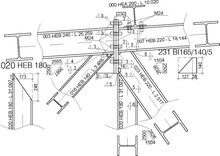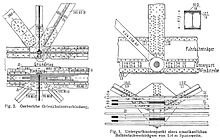
Back جمالون Arabic Ферма (канструкцыя) Byelorussian Ферма (конструкция) Bulgarian Gelosia (estructura) Catalan Příhradová konstrukce Czech Fachwerk German Ĵaluzio (strukturo) Esperanto Armadura (estructura) Spanish Kandesõrestik Estonian خرپا Persian



A truss is an assembly of members such as beams, connected by nodes, that creates a rigid structure.[1]
In engineering, a truss is a structure that "consists of two-force members only, where the members are organized so that the assemblage as a whole behaves as a single object".[2] A "two-force member" is a structural component where force is applied to only two points. Although this rigorous definition allows the members to have any shape connected in any stable configuration, trusses typically comprise five or more triangular units constructed with straight members whose ends are connected at joints referred to as nodes.
In this typical context, external forces and reactions to those forces are considered to act only at the nodes and result in forces in the members that are either tensile or compressive. For straight members, moments (torques) are explicitly excluded because, and only because, all the joints in a truss are treated as revolutes, as is necessary for the links to be two-force members.
A planar truss is one where all members and nodes lie within a two-dimensional plane, while a space frame has members and nodes that extend into three dimensions. The top beams in a truss are called 'top chords' and are typically in compression, the bottom beams are called 'bottom chords', and are typically in tension. The interior beams are called webs, and the areas inside the webs are called panels,[3] or from graphic statics (see Cremona diagram) 'polygons'.[4]
- ^ "Definition of TRUSS". 7 March 2024.
- ^ Plesha, Michael E.; Gray, Gary L.; Costanzo, Francesco (2013). Engineering Mechanics: Statics (2nd ed.). New York: McGraw-Hill Companies Inc. pp. 364–407. ISBN 978-0-07-338029-2.
- ^ Ching, Frank. A Visual Dictionary of Architecture. 2nd ed. Hoboken, N.J.: Wiley, 2012. 277. Print. ISBN 9780470648858
- ^ Bow R. H., Economics of construction in relation to framed structures. Spon, London, 1873